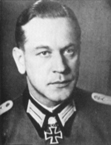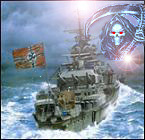HansBolter
Posts: 7704
Joined: 7/6/2006
From: United States
Status: offline

|
I would like to provide some constructive criticism in the form of a critique. I realize most people don’t take criticism well and will endeavor to avoid being as caustic as I have a tendency to be on occasion.
First a little background, so you will hopefully take my critique seriously. I have been an avid wargamer for over 35 years, cutting my teeth in the early 1970s. My boardgame collection alone, numbers somewhere just over 200 titles. You will find my name (the real one, accessible in my profile) in the design credits of your old dusty copy of Advanced Third Reich listed as a playtester. I am currently a beta tester for Panther Games (a Matrix affiliate) engaged in testing the upcoming release of Battles from the Bulge. I state this not to impress but only to hopefully lend some credence to my observations.
The single biggest flaw I see in this game is the choice of the physical/temporal scale ratio, which I see as the real reason for your introduction of the Areas of Operation. When the temporal scale is too great in relation to the physical scale units have the capability to move almost the entire length and breadth of the map in a single turn. I see units in the game with sufficient Operation Points to be able to move halfway or more across the entire board in one turn with the average cost of movement through a clear terrain hex being two movement points. I have seen this phenomenon in games before. The one that comes to mind first is an old GDW board game titled Road to the Rhine. Units in that game could move across the entire breadth of France in a single game turn. This has a strong tendency to throw the game into a tizzy. Players will find it almost impossible to make plans when their enemy can completely redeploy everything on the board all the way across the board each and every turn. The real reason for your introduction of AOs seems to me to have been to reign in the undesirable side effects of what appears to have been a poor choice for the scale ratio. Your professed reason, reigning in historical hindsight, is really just a smokescreen, isn’t it, albeit a very good one?
For the physical scale chosen, I believe a much better choice for temporal scale would have been four six hour turns per day, or at a minimum three eight hour turns per day, which would better facilitate the division between night and day turns. Three eight hour turns per day could be easily divided into two day turns and one night turn. This would have changed your 16 turn game into a 48 turn game. Doing this would have also helped to make the game more appealing to potential customers like Judge Dread who would likely have had less concerns about a potential lack of content. The operations points available to units for three eight hour turns per day would have almost completely obviated the need for the introduction of the AOs. Of course, the introduction of night turns would have greatly increased your workload as mechanics would have had to be implemented for night movement, night combat and fatigue as a result of being active at night.
On to the manual. I found the manual to be frustrating almost to the extreme. The manual is full of rules and references that have absolutely nothing to do with this game (meaning this scenario). Even section 1.0 makes no mention of, or distinction between, the game engine and the game. Many of the rules for the game engine have no relevance to this game. I found myself constantly being frustrated with being inundated with info I don’t need to play this game and generic references to the way scenario designers can set things. What’s important to me in learning how to play this game is what the scenario designer of this game did set them to, not what potential designers of potential future scenarios can set them to. Someday when some one does indeed design a scenario including naval units and amphibious invasions, then, and only then, will I need to be concerned with learning about how they work. This game is in the middle of the steppes of Russia, don’t distract me with details about naval bombardment and amphibious invasions.
What I suggest would have been an improvement would have been to provide separate manual sections for the elements of the game engine included in, and pertinent to, this game, while including a section at the back of the manual outlining all the potential game mechanics that may appear in future scenarios and that those inclined to engage in scenario design can take advantage of. Another negative side effect of the repeated mentions of things not included in this game is that it serves to reinforce the perception that the single scenario represents limited content.
Sections of the manual appear to be poorly written. For example, section 16.1 endeavors to explain that for multi-unit formations one unit is designated as the Minor headquarters. It goes on to attempt to explain that the Minor HQ should not be confused with Formation HQs. Well, of course this clarification was needed because you refer to both the divisional multi-unit formation with the Minor HQ with the same undifferentiated terminology as the Corps level Formation. You call them both simply formations with no distinction. You cause the confusion by failing to differentiate clearly and concisely between the minor and major formation. The second best example is section 24.1. No where in this section does it clearly and concisely state that more than one unit can engage in close combat at a given time. Not until section 24.4 does it even begin to hint that multiple units can participate by referring to the addition of combat shifts for attacks coming from multiple hexes. I realize you may not think this important at first, but it relates directly to the new limitations in this game where only one unit at a time can be activated on the tactical map for movement. If only one unit at a time can be active for movement, how exactly does a player commit multiple units from multiple hexes to an attack? In the DB series it could be done either on the tactical map by selecting and activating all the intended units, or by selecting the adjoining hexes in the combat interface and assigning the additional units there. Perhaps I missed it, but I did not see an explanation anywhere of which of these two techniques can or must be used in this game.
In at least two places somewhat arcane cultural idioms are utilized that I believe should have been avoided. In one place in the manual there is a reference to the player being able to do something “straight away”. While I understand that it is intended to mean that the player can take this action “immediately thereafter”, the meaning of the idiom may not be clear to some. Do you know what the term “straight away” normally means to me? It means the part of the race track that is not the curve. The other place I noticed the use of an idiom that I feel should have been avoided and for better reason is in the game itself. On the German first turn the turn starts with a briefing. The briefing refers to “writing down” the enemy. This is a decidedly British/Australian idiom that I feel has no place in a briefing to a German commander on the eastern front. It serves to burst the bubble of immersiveness. When I take on the role of the German commander I want my briefing to be given as if presented by a German staff officer, not a British one. In point of fact, some might not even grasp the meaning. I mentioned it to my boardgame group last night and at least one of the four of us didn’t know the meaning, in spite of the fact that he has been a wargamer for over twenty years (he is not as well read with regards to military history as the other three of us).
A few words to Matrix about the graphic presentation of the manual, please, please, please drop the attempt to be overly artistic with the parchment like paper background with screen tone imagery that only serves to make the text almost illegible in some locations. When you choose to print a manual in black and white instead of color please take into consideration the potential problems regarding the contrast of very dark colors printing as very, very dark grey. Take a look at the game panels illustrated on pages 26, 27, 28, 29, 31 and 80 for examples of how illegible they have become when printed in black and white. In addition, much of the text explanations make reference to the colors of elements within the illustrations that are not printed in color.
I hope you will not take offense at this critique. I have endeavored to present it as constructively as I know how. My aim is not to trash you for what I perceive as shortcomings, but to provide you with the type of feedback I believe you need to stay on top of producing products that will keep you in business. I would hate to see this release of your first scenario in this new game engine fall as flat as Battlefront seems to have. I own and enjoy playing every game in the DB series and Battlefront. I have been a loyal customer and I hope you will give real consideration to the points I have made here rather than getting bent out of shape (yes I used a cultural idiom) and becoming defensive over them.
Sincerely,
Merrill David Wright aka HansBolter
|
 Printable Version
Printable Version







 ). I enjoyed the read and it all makes sense.
). I enjoyed the read and it all makes sense. 
 . "Are you rich enough to buy our games?"
. "Are you rich enough to buy our games?"




 New Messages
New Messages No New Messages
No New Messages Hot Topic w/ New Messages
Hot Topic w/ New Messages Hot Topic w/o New Messages
Hot Topic w/o New Messages Locked w/ New Messages
Locked w/ New Messages Locked w/o New Messages
Locked w/o New Messages Post New Thread
Post New Thread